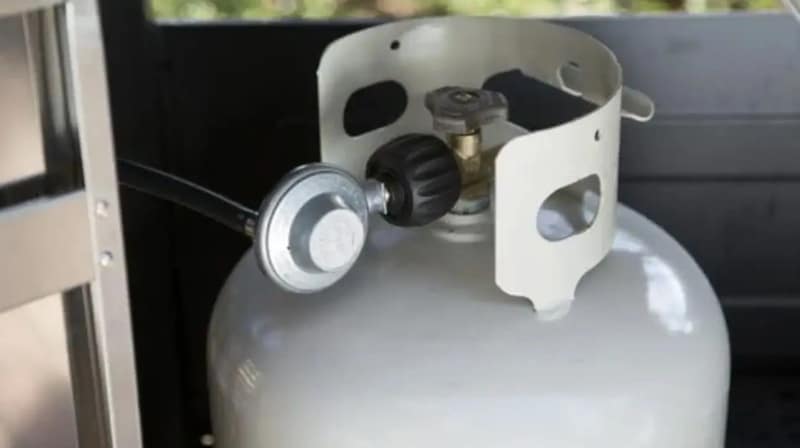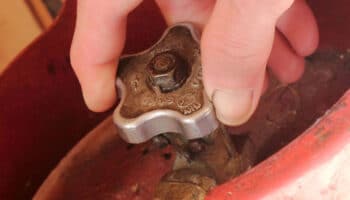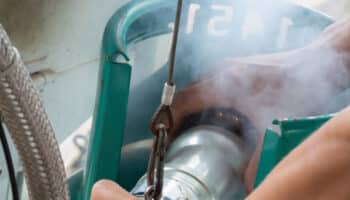We've independently reviewed this article to make sure it's as accurate as we can make it.
To find out more about our article creation and review process, check out our editorial guidelines.
Are you trying to use a propane-powered appliance and find it not working or the gas not igniting? Have you checked the tank valve to ensure it’s open and found no gas flowing?
A lack of propane flow is a big problem and will impact your ability to use any propane appliances. But before you can fix your flow problem, you need to identify why there’s a problem in the first place.
So, if your propane tank valve is open, but no gas is coming out, you’ll need to start looking into the possible reasons behind the situation. And luckily, you’re about to find all the answers you’ve been looking for.
Ready? Let’s go!
Fixing a Tank With an Open Valve but No Gas Flow
In my experience, there are many reasons why your propane tank might have an open valve but provide no gas flow. To address the issue from the source, it’s important to look at every possible angle and take action. Here are some of the things I like to check first.
#1 Check the Tank’s Content
I know the question might seem a little obvious, especially if you just refilled the tank. However, if your propane tank’s valve is open, but no gas is coming out, something’s clearly not right.
What if you have a leak? Or what if you were told the tank was refilled but found out it wasn’t?
The answer is: It doesn’t hurt to check.
Now, if you have a tank level gauge on your tank, then it’s an easy check. However, most tanks don’t come with a gauge But don’t worry; there are other ways to check your gas levels.
If your tank is a 20 – 80 lb model, you can pick it up and shake the tank. If you can’t lift heavy objects, you can always ask someone for help. Make sure the tank valve is closed and disconnected before trying.
It won’t take much to notice if:
- The tank is light.
- There’s no sound of liquid sloshing around.
From what I’ve seen, if your tank is light and there’s no sound, it is either empty or almost empty.
Another thing you can do is pour warm water down the side of your tank. Touch the tank in different areas where the water made contact. Because propane is naturally cold, it will absorb the heat of the warm water. If you feel a cold spot, that’s the level of your propane. If you don’t feel any cold, your tank is probably empty.

#2 Reconnect Your Tank as if It’s the First Time
If your propane tank valve is open, but no gas is coming out, ask yourself the following question. Do you have to disconnect and reconnect your propane tank on a somewhat regular basis because you’re a regular propane user? If so, why not repeat the process to ensure you haven’t missed anything?
The reason for taking the above approach is because when something is a habit, it’s natural for a person to go through the motions without thinking if they did something in the right order or forgot to do something they should have.
Go back and retrace your steps. Is the control valve closed? Is the tank valve closed? Is the tank valve open all the way? Do you normally open the valve all the way when you reconnect the tank?
I tend to find that if the tank valve is wide open, the gas flow will exceed the safety limit, and the tank will lock out. Chances are, you need to look at the position of your gas valve a bit closer and move it near the “off” position slightly to restore gas flow.
It’s important to note that gas connections use left-handed threads that serve as a reminder that you’re dealing with a gas pipe, not a water pipe! Make sure not to use a ton of force trying to twist a connection to the right. Turning the thread clockwise may seem a little strange since we’re so used to turning counter-clockwise.
#3 Check Your Connections
Another possible reason your propane tank valve is open but no gas is coming out is a mismatched connection.

Mismatched connections are common, especially if it’s your first time hooking up a propane tank to your appliance of choice.
Tanks that are regularly refilled come equipped with a valve called an Overfilling Protection Device, or OPD. It’s essentially a check valve that prevents gas from coming out of the tank even if your tank valve is open.
The only way to allow gas to flow out of the tank is to hook up a hose with a connector greater than one inch long. Less than one inch and the check valve won’t get actuated. No check valve actuation = no gas flow.
If it’s not your first time hooking up an appliance and you’ve never experienced a flow issue before, your connector is probably greater than an inch. The reason is that all new small-capacity tanks started being manufactured with OPDs in 1998.
Even though older models are still out there without an OPD, if you’ve been refilling or swapping tanks, you’ve probably been using tanks with OPDs.
A quick way to check, besides the length of the connector, is to check the hand wheel on the tank valve. If the hand wheel is round or star-shaped, you’ve got an old non-OPD tank, but if it has a triangle hand wheel, you’ve got an OPD tank.

#4 While You’re Checking Your Connector’s Length
If your propane tank valve is open, but there’s still no gas, you’ll want to ensure your gas line is connected properly.
If not, your tank regulator will prevent gas from flowing.
#5 Check for Leaks
If your propane tank valve is open, but there’s still no gas, check for leaks. All it takes is some soapy water and a spray bottle.
Take a bottle of soapy water and spray in areas where leaks might occur, such as around the tank valve, connection, and regulator. If you see the solution start to bubble regularly, it’s a sign of a leak.
Another typical sign of a leak is a strong sulfur smell, which is added to the propane as a warning system.
#6 If All Else Fails
If everything so far has failed to remedy your lack of gas flow problem, you’ll want to replace the regulator, as the replacement can solve the problem and certainly won’t hurt. Regulators do go bad, so replacing them isn’t an uncommon occurrence.
You can also see if swapping out the tank works.
Lastly, there’s always the choice of calling a technician. It’s okay to try and take on things yourself, but if you feel uncomfortable or uncertain at any point, put your safety first.
Conclusion
That about covers it!
When your propane tank valve is open but no gas is coming out, your plans for heating a small appliance or turning on your grill can be cut short.
Luckily, as I hope this piece has helped you better understand, addressing the most common causes behind a propane tank with no gas flow is easy and quick. More often than not, something as simple as checking the gas line is properly secured and ensuring the valve is not wide open will do the trick.
Thanks for reading. If this article piqued your interest and answered your most burning questions, please check out our other incredible resources below and consider subscribing to our newsletter. On the site, we have all sorts of solutions and guides for everyday appliance issues, such as a furnace not turning on.
Have a great day!
-Craig.








